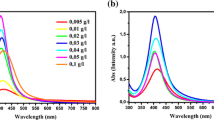Abstract
Silver nano-hexagons have been prepared through the reduction of silver ions by ethylene glycol with poly (vinyl pyrrolidone) (PVP) as a capping agent or stabilizing agent. The morphology and structure of these nano-hexagons have been investigated using high-resolution transmission electron microscopy (HRTEM). The X-ray diffraction study shows that the nanoparticles are crystalline in nature and mainly composed of face-centered cubic (fcc) silver, and from Scherer equation, the average size has been calculated as 45 nm (approx), whereas HRTEM image shows that the average size of silver nano-hexagons is 50 nm. Further, high-performance liquid chromatography (HPLC) study reveals the monodispersity of the nanoparticles, which matches well with the narrow size distribution as observed in TEM analysis. UV/Vis study gives an absorption peak at 410 nm due to surface plasmon resonance (SPR), whereas photoluminescence (PL) spectra of silver nano-hexagons show an emission peak at 490 nm, when excited at 390 nm.







Similar content being viewed by others
References
Kreibig U, Vollmer M (1995) Optical properties of metal clusters. Springer, New York
El-Sayed MA (2001) Some interesting properties of metals confined in time and nanometer space of different shapes. Acc Chem Res 34:257–264
Kreibig U, Genzel L (1987) Optical absorption of small metallic particles. Surf Sci 156:678–700
Smitha SL, Nissamudeen KM, Philip D, Gopchandran KG (2008) Studies on surface plasmon resonance and photoluminescence of silver nanoparticles. Spectrochim Acta A 71:186–190
Link S, El-Sayed M (2000) Shape and size dependence of radiative, non-radiative and photothermal properties of gold nanocrystals. Int Rev Phys Chem 19:409–453
Haldar KK, Sen T, Mandal S, Patra A (2012) Photophysical properties of Au‐CdTe hybrid nanostructures of varying sizes and shapes. ChemPhysChem 13:3989–3996
Ahmadi TS, Wang ZL, Green TC, Henglein A, El-Sayed MA (1996) Shape-controlled synthesis of colloidal platinum nanoparticles. Science 272:1924
Liu X, Huang R, Zhu J (2008) Functional faceted silver nano-hexapods: synthesis, structure characterizations, and optical properties. Chem Mater 20:192
Das R, Nath SS, Bhattacharjee R (2010) Preparation of linoleic acid capped gold nanoparticles and their spectra. Physica E 43:224–227
Das R, Nath SS, Bhattacharjee R (2011) Luminescence of copper nanoparticles. J Lumin 131:2703–2706
Sun YG, Yin YD, Mayers BT, Herricks T, Xia YN (2002) Uniform silver nanowires synthesis by reducing AgNO3 with ethylene glycol in the presence of seeds and poly(vinyl pyrrolidone). Chem Mater 14:4736–4745
Birkholz M (2006) Thin film analysis by X-ray scattering. Wiley-VCH Verlag GmbH and Co. KGaA, Weinheim
Rogers KD, Daniels P (2002) An X-ray diffraction study of the effects of heat treatment on bone mineral microstructure. Biomaterials 23:2577
Wilcoxon JP, Martin JE, Provencio P (2001) Optical properties of gold and silver nanoclusters investigated by liquid chromatography. J Chem Phys 115:998–1008
Wei GT, Liu FK, Wang CRC (1999) Shape separation of nanometer gold particles by size-exclusion chromatography. Anal Chem 71:2085–2091
Song Y, Jimenez V, McKinney C, Donkers R, Murray RW (2003) Estimation of size for 1–2 nm nanoparticles using an HPLC electrochemical detector of double layer charging. Anal Chem 75:5088–5096
Wilcoxon JP, Martin JE, Provencio P (2000) Size distributions of gold nanoclusters studied by liquid chromatography. Langmuir 16:9912–9920
Cako G (2004) Nanostructures and nanomaterials. Imperial College Press, London
Strashko AA, Agranovich VM (2014) To the theory of surface plasmon-polaritons on metals covered with resonant thin films. Opt Commun 332:201–205
Molina RA, Weinmann D, Jalabert RA (2002) Oscillatory size dependence of the surface plasmon linewidth in metallic nanoparticles. Phys Rev B 65:155427
Mooradian A (1969) Photoluminescence of metals. Phys Rev Lett 22:185
Link S, El-Sayed MA (1999) Size and temperature dependence of the plasmon absorption of colloidal gold nanoparticles. J Phys Chem B 103:4212–4217
Zhang A, Zhanga J, Fang Y (2008) Photoluminescence from colloidal silver nanoparticles. J Lumin 128:1635–1640
Zhao Y, Jiang Y, Fang Y (2006) Spectroscopy property of Ag nanoparticles. Spectrochim Acta A 65:1003–1006
Yeshchenko OA, Dmitruk IM, Alexeenko AA, Losytskyy MY, Kotko AV, Pinchuk AO (2009) Size-dependent surface-plasmon-enhanced photoluminescence from silver nanoparticles embedded in silica. Phys Rev B 79:235438
Philip D (2008) Synthesis and spectroscopic characterization of gold nanoparticles. Spectrochim Acta A 71:80–85
Hu H, Duan H, Yang JKW, Shen ZX (2012) Plasmon-modulated photoluminescence of individual gold nanostructures. ACS Nano 6:10147–10155
Reisfeld R, Saraidarov T, Levchenko V (2008) Formation and structural characterization of silver nanoparticles in ormosil sol–gel films. Opt Appl XXXVIII:1
Das R, Sarkar S (2015) Optical properties of silver nano-cubes. Opt Mater 48:203–208
Shasmal N, Karmakar B (2015) Localized surface plasmon absorption and photoluminescence of in situ-generated nano silver in a novel chloroborosilicate glass and glass ceramics. Plasmonics 10:191–202
Lin A, Son DH, Ahn IH, Song GH, Han WT (2007) Surface plasmon polariton beam focusing with parabolic nanoparticle chains. Opt Express 6576:10
Nandhikonda P, Begaye MP, Cao Z, Heagy MD (2010) Frontier molecular orbital analysis of dual fluorescent dyes: predicting two-color emission in N-aryl-1,8-naphthalimides. Org Biomol Chem 8:3195–3201
Nandhikonda P, Begaye MP, Cao Z, Heagy MD (2009) Discovery of dual fluorescent 1, 8-naphthalimide dyes based on balanced seesaw photophysical model. Chem Commun 4941:4941–4943
Wilcoxon JP, Martin JE, Parsapour F, Wiedenman B, Kelley DF (1998) Photoluminescence from nanosize gold clusters. J Chem Phys 108:9137–9143
Boyd GT, Yu ZH, Shen YR (1982) Photoinduced luminescence from the noble metals and its enhancement on roughened surfaces. Phys Rev B 33:7923–7936
Liao H, Wen W, Wong GKL (2006) Photoluminescence from Au nanoparticles embedded in Au:oxide composite films. J Opt Soc Am 25:2518–2521
Das R, Nath SS, Bhattacharjee R (2011) Synthesis of linoleic acid capped copper nanoparticles and their fluorescence study. J Fluoresc 21:1165–1170
Acknowledgments
Authors are thankful to the SAIF, NEHU, Shillong, India, for conducting the TEM analysis; Mr. Ratan Boruah, T.A., Department of Physics, Tezpur University, Assam, India, for the XRD study; and Dr. Gautam Gope, S.O., CIL, Assam University, Silchar, India, for the assistance during the HPLC analysis.
Author information
Authors and Affiliations
Corresponding author
Rights and permissions
About this article
Cite this article
Sarkar, S., Das, R. Photoluminescence Study of Silver Nano-hexagons. Plasmonics 11, 551–556 (2016). https://doi.org/10.1007/s11468-015-0082-4
Received:
Accepted:
Published:
Issue Date:
DOI: https://doi.org/10.1007/s11468-015-0082-4




